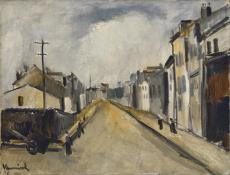


An athlete and a cyclist, a violinist and a novelist, an author of pamphlets and mordant memoirs, Maurice de Vlaminck remains one of the most prominent painters of the 20th century. Selftaught, a fact he forcefully defended, Vlaminck owed to André Derain (1880-1954), whom he met in 1900 and with whom he shared a studio in Chatou, on the banks of the Seine, his decision to pursue an artistic career.
Vlaminck was a Fauve in 1905, revealing a tempestuous temperament, at the Salon d’Automne, in canvases saturated with pure colour – red, green, blue, yellow, areas of solid colour or comma-shaped brushstrokes inherited from Vincent van Gogh (1853-1890). His penchant for a certain ‘primitivism’ made him one of the first artists to become keenly interested in African art. The art dealer Ambroise Vollard (1866- 1939) bought his paintings in 1906 and organised a solo exhibition for him in 1907, which drew much attention. From 1907, Vlaminck allowed himself to be influenced by Paul Cézanne (1839-1906), a fact which also brought him in brief contact with the Cubists and led the celebrated art dealer Daniel-Henry Kahnweiler (1884-1979) to put him under contract before World War I. An exhibition in 1919 at the Galerie Druet announced Vlaminck’s comeback after the war. During these years, the artist adopted a more supple handling of the brush and darker colours. Initiating a very personal style of painting, he abstained from all forms of abstraction and continued thus until the end of his life. From the outset, roads were one of Vlaminck’s preferred motifs. He would organise his Fauvist landscapes according to a rowdy perspective, while firmly anchoring the elements of the painting in their frame.
The subsequent evolution of his palette produced – during the 1920s, the probable date of the painting in the A. G. Leventis Collection – a series of suburban and sad country views, an expression of the painter’s personal anxiety and a mirror of his disenchantment. Bleak buildings without character line an empty road all the way to the horizon; only a few allusive silhouettes of passers-by animate the scene. The tones are broken, and greys and ochres dominate, which makes the eye appreciate all the more the touches of orange, blue or green that subtly punctuate the rapidly painted pictorial surface. Vlaminck strongly asserted the intense individualism of his paintings. His talent allowed him to create powerful images capable of immediately touching the viewer and helped him win wide public acclaim. His snowy landscapes crossed by dark ruts under leaden skies, his long, blue-grey walls, sometimes interrupted by vegetation of a strident green, bordering on roads fleeing at oblique angles, are all aspects readily associated with the painter’s later work, which also includes still lifes, simple objects painted with a rich impasto, or bouquets of flowers of spectacular colours, in which he regained the energy which had governed his Fauve period.
A man of diverse talents – painter, printmaker, writer, cyclist and violinist – and celebrated for his colourful personality, he was one of the most prominent painters of the 20th century. In 1900 he met André Derain, who encouraged him to pursue art, and the two then shared a studio. Self-taught, he became, along with Derain and Henri Matisse, a leader of the Fauve movement, creating startling canvases with saturated pure colours applied in a rich impasto. Around 1907 the influence of Paul Cézanne led him to adopt a darker palette. Although he is perhaps best known for his landscapes, he also painted some portraits and still lifes.